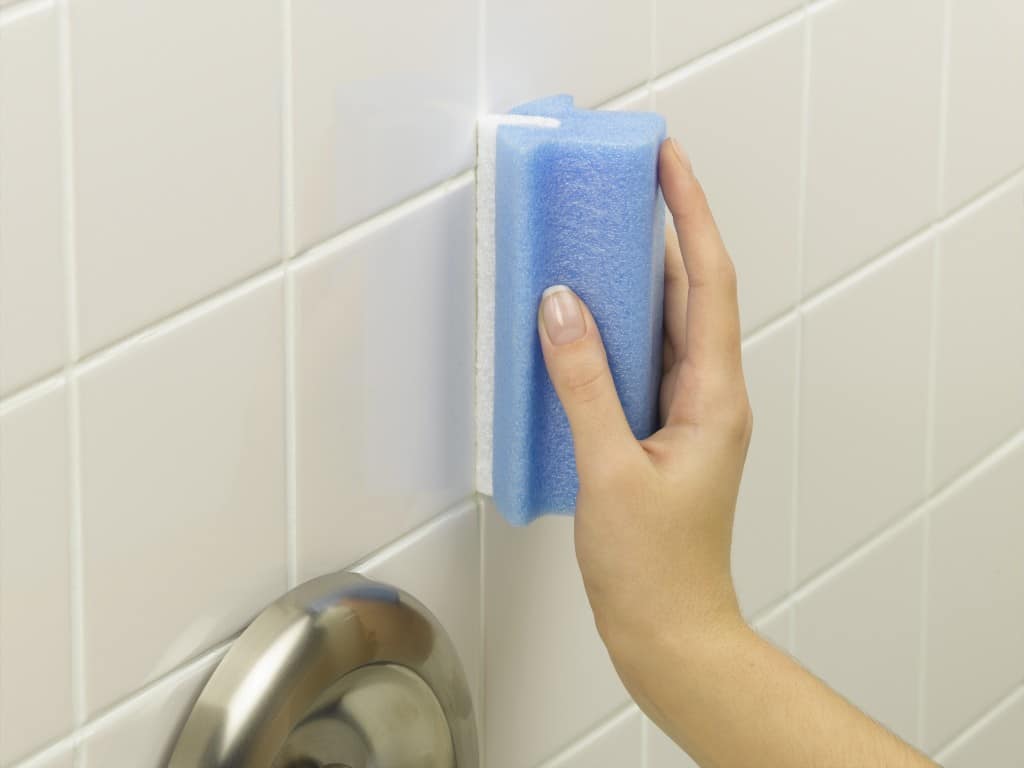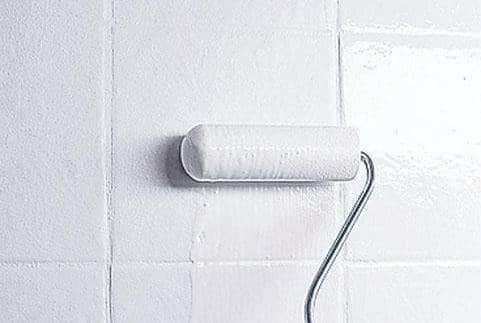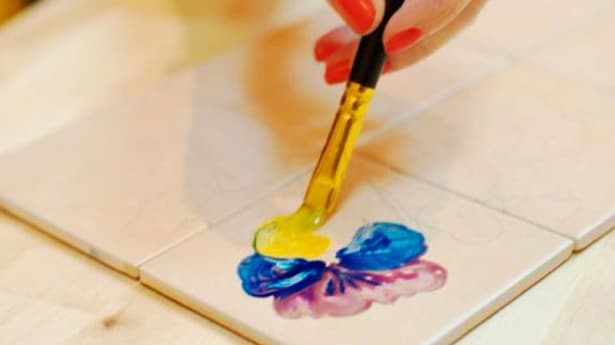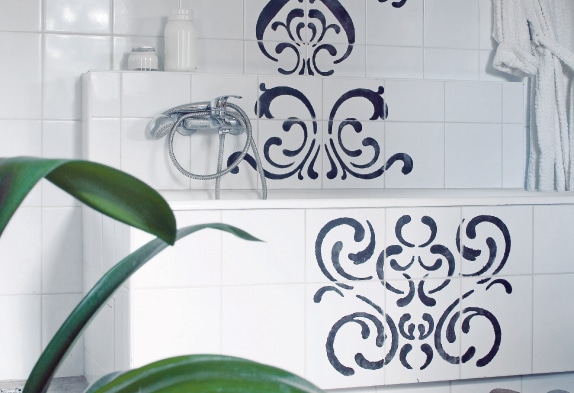How to paint bathroom tiles: paint selection rules and step-by-step instructions
If the tile has lost its original appearance, but the structure has retained its integrity, you can refresh the old coating in a quite budgetary and quick way - by painting. By learning how to paint tiles, you can quickly and effectively eliminate minor defects in the finishing material or change the design of the bathroom.
You can apply a new coating only on the tile that is located on the walls. Layed on the ceiling or floor must not be painted - due to hot steam and water, the paint on these surfaces will begin to peel off.
Can tile be painted with water-based paints? Such compositions are best suited for interior work, however, water-based paints are washed off with water, and therefore they are not suitable for bathrooms - rooms with high humidity.
It is recommended to use acrylic and latex paints - they are also odorless, dry quickly and have a non-toxic composition, therefore they are suitable for finishing residential premises. Another good option is epoxy compounds. However, the process of applying them requires some skills, and therefore, before painting the tiles, you should first practice on other surfaces.
Car paint for bathroom tiles is also suitable: it is designed specifically for smooth surfaces, resistant to high humidity. The dried coating can be washed, and it will not lose its original appearance for a long time.
Oil paints are great for painting tiles - they lie flat, adhere well to a smooth surface, and remain intact for years. However, they take a long time to dry and have a strong smell. They should not be used in residential areas.
Possible staining options
Tile color optionsYou can paint the tiles in the bathroom in various ways, the most popular are the following:
- Full coloration. In this method, the paint is applied to the entire tile, from floor to ceiling. Any paint is used for this purpose, repainting in the opposite of the original color is allowed.
- Partial. Only certain sections are painted - for example, if the wall was lined with plain tiles, they change the color of individual elements (stripes, checkerboard cells, etc.).
- The return of color. In this case, the color of the tile does not change dramatically, but only returns its original brightness.
- Picture. Using a template or by hand, a pattern or pattern is applied to a tile previously painted in the base color or left untouched.
There are other options - tiles can serve as the basis for creating a panel or a picture on the whole wall, but in this case you need to have sufficient artistic skills, such projects are more difficult to implement, and therefore they are less popular.
Materials and tools
For work you will need:
- primer;
- paint for tiles, selected according to the recommendations;
- roller;
- brushes of different sizes;
- liquid detergent (for example, Fairy);
- masking tape;
- sponge;
- polyethylene film;
- clean rags;
- vinegar or any alcohol-containing liquid;
- sandpaper;
- water-based varnish (it will not turn yellow over the years, unlike ordinary);
- stencil or template for applying a pattern (if planned).
Surface preparation
In order for the paint to lay flat, the tile must first be prepared.
Procedure:
- Surfaces are thoroughly cleaned of dust, dirt, soap deposits, rust and lime deposits and other contaminants. To do this, the detergent is diluted in warm water and a sponge is passed over the entire area for painting.
- Inter-tile seams and joints are qualitatively cleaned - if dirt is left in them, mold will form there over time.
- The tile is degreased using a rag moistened with alcohol or vinegar.
- Using fine-grained sandpaper, grind the surfaces so that the paint adheres more firmly.
- If there are damages on the tile (scratches, chips or cracks), they are repaired with a primer specially designed for this purpose.
 Surface preparation before painting tiles
Surface preparation before painting tiles Coloring
When the primer dries, using a film and masking tape, glue objects adjacent to the tile and sections of the wall that they plan to leave intact.
The most convenient way to apply paint is with a foam roller - it ensures uniform distribution of paint over the surface, allows you to quickly paint large areas. This is useful if you want to paint the entire wall in one color.
Monochromatic coloring
First, the first coat of paint is applied, which will serve as the base. When it dries completely, start applying the second. If the paint of the tile is different from what is planned to be applied, then a third coat may be required, otherwise the base will be visible under the new coating.
 Single color tile
Single color tile Until the paint dries completely, it is not recommended to use the bath - water can blur the pattern, soap splashes or dust will remain on the paint, which will damage the coating.
Painting tiles in different colors
You can paint on the wall. This can be done in different ways: by pre-painting the wall with the base color, and then using a stencil or drawing with a brush, or by directly applying the pattern to the tile, without pre-painting.
To make a pattern on a tile, the stencil is fixed with adhesive tape on the desired section of the wall, and then the paint is applied with a roller, brush, or sprayed from an aerosol can.
drawing
 Drawing a picture on a tile
Drawing a picture on a tile If you plan to apply a picture, then you will need to use brushes. It is better to choose those with soft bristles - the hard pile leaves marks, and the strokes after drying will be noticeable.
Using a stencil
In hardware stores, you can find a lot of ready-made stencils for painting, with which you can transfer a wide variety of drawings and patterns to the bathroom wall.
However, if the assortment of finished products is not enough, you can make a stencil with your own hands. To do this, first print the drawing or photo you like, and then transfer the image to a dense material (cardboard, for example). Carefully cut with scissors and use as usual.
It is most convenient to apply paint with a special foam swab for drawing - with its help, the paint will lay down evenly, forming a smooth surface, while strokes remain visible after the brush.
Important! When using a foam pad, do not press too hard on it. When pressed, too much paint flows out of the tool, causing streaks to form on the drawing.
Tile decoration
 Decorating tiles in the bathroom
Decorating tiles in the bathroom To create spectacular geometric patterns on the tile, you can also use masking tape - pasted on the desired areas, it will help to achieve clear and even lines. After removing such adhesive tape, no traces of glue remain on the surface.
3D effect
This method of decoration is increasingly used for decorating rooms, including the bathroom.
You can create a visually three-dimensional pattern or drawing with your own hands. This will require gauze. Elements of the pattern are cut out of it, then they are glued onto surfaces prepared in accordance with all the rules. Color the area of the drawing first in the base color. When the first layer dries, a layer of paint is applied to the entire wall using a roller, which differs from the previously used one by several tones. This technique allows you to achieve the best effect.
Lacquer application
In order for the paint to remain bright and not damaged over time, it is recommended to coat it with varnish. Such a measure will significantly increase the service life of the coating, and the water-based varnish, which is recommended for use during work, will not turn yellow over the years, but will retain its transparency.
Lacquering of surfaces is started only after the final drying of the paint. If you work immediately, there will be stains on the tile.
Tile painting is an affordable and easy way to make a big difference in your bathroom. It will not take much time and money to work, but the new coating will be durable and bright, and will last, if everything is done according to the instructions, for about 10 years.






